Geochemical Characteristics of Organic-Enriched Shales in the Upper Ordovician–Lower Silurian in Southeast Chongqing
Abstract
1. Introduction
2. Regional Geological Conditions
- First subsegment: Predominantly gray–black carbonaceous graptolite shale exhibiting an abundant distribution of graptolite fossils along layers. From bottom to top, the graptolite content progressively declines. Occasional radiolarians and a small amount of sponge bone needle fossils are visible alongside various types of pyrite. Horizontal bedding in shale is prominent.
- Second subsection: This section is composed mainly of black–gray carbon-containing silty mudstone with tiny areas of dark-gray carbon-containing argillaceous siltstone. Silty and argillaceous stripes are distributed within the shale matrix. This subsection contains a certain amount of graptolites and a smaller quantity than the first subsegment. Pyrite mainly occurs in laminae.
- Third subsection: The lower lithology consists primarily of gray–black graptolite carbonaceous shale that transitions to the upper part, which is characterized by black–gray silt-bearing mudstone with a less developed horizontal bedding structure. Graptolites are present throughout this section along with a small amount of radiolarians; however, powdery pyrite only exists in the lower portion.
3. Samples and Test Methods
4. Results
4.1. Characteristics of the Mineral Content
4.2. Major Element Geochemistry
4.3. Trace Element Geochemical Data
5. Discussion
5.1. Provenance Analysis
5.1.1. Ancient Weathering and Sedimentary Recycling
5.1.2. Type of Source Rock
5.2. Paleoenvironment
5.2.1. Paleoclimate
5.2.2. Paleo–Redox Conditions
5.2.3. Ancient Productivity Level
5.2.4. Water Retention Environment
5.3. Enrichment Mechanism of Organic Matter
6. Conclusions
- (1)
- Geochemical indicators revealed a weak degree of weathering and negligible sedimentary recycling. The provenance of the Wufeng–Longmaxi Formations primarily consisted of felsic acidic rocks, with minor contributions from ancient sedimentary rocks.
- (2)
- A suite of paleoclimate proxies, including Sr, Sr/Cu, and CIA, clarified the transition from a moist to a dry climate in the Wufeng–Longmaxi phase. Moreover, the geochemical characteristics imply that the deposition of the Wufeng–Longmaxi Formations occurred in an oxygen-deprived paleoenvironment with moderate–high ancient productivity and a moderately–strongly restricted setting.
- (3)
- The organic enrichment mechanism of the Wufeng–Longmaxi Formation is different. In the case of the Wufeng Formation, the accumulation of organic matter is attributed primarily to strongly restricted conditions, resulting in significant anoxic environments. Furthermore, the correlation between paleoredox conditions and TOC further reinforces the idea that these conditions are the crucial factor influencing the organic accumulation in the Longmaxi Formation.
Author Contributions
Funding
Data Availability Statement
Acknowledgments
Conflicts of Interest
References
- Feng, Z.Q.; Hao, F.; Tian, J.Q.; Zhou, S.W.; Dong, D.Z. Shale gas geochemistry in the Sichuan Basin, China. Earth Sci. Rev. 2022, 232, 104141. [Google Scholar] [CrossRef]
- Curtis, J. Fractured shale gas system. AAPG Bull. 2002, 86, 1921–1938. [Google Scholar]
- Zou, C.N.; Dong, D.Z.; Wang, Y.M.; Li, X.J.; Huang, J.L.; Wang, S.F.; Guan, Q.Z.; Zhang, C.C.; Wang, H.Y.; Liu, H.L.; et al. Shale gas in China: Characteristics, challenges and prospects (II). Pet. Explor. Dev. 2016, 43, 166–178. [Google Scholar] [CrossRef]
- Zou, C.N.; Zhu, R.K.; Chen, Z.Q.; James, O.; Tao, S.Z.; Dong, D.Z.; Qiu, Z.; Wang, Y.M.; Wang, L.; Lu, S.H.; et al. Organic-matter-rich shales of China. Earth Sci. Rev. 2019, 189, 51–78. [Google Scholar] [CrossRef]
- Milkov, A.V. New approaches to distinguish shale-sourced and coal-sourced gases in petroleum systems. Org. Geochem. 2021, 158, 104271. [Google Scholar] [CrossRef]
- Fu, C.Q.; Du, Y.; Song, W.L.; Sang, S.X.; Pan, Z.J.; Wang, N. Application of automated mineralogy in petroleum geology and development and CO2 sequestration: A review. Mar. Pet. Geol. 2023, 151, 106206. [Google Scholar] [CrossRef]
- Gordon, D.; Sautin, Y.; Tao, W. China’s Oil Future; Carnegie Energy and Climate Program; Carnegie Endowment for International Peace: Washington, DC, USA, 2014; p. 11. Available online: https://carnegieendowment.org/research/2014/05/chinas-oil-future?lang=en (accessed on 11 February 2025).
- Lazar, R.; Bohacs, K.M.; Schieber, J.; Macquaker, J.; Demko, T. Mudstone Primer: Lithofacies Variations, Diagnostic Criteria, and Sedimentologic/Stratigraphic Implications at Lamina to Bedset Scales. SEPM Concepts Sedimentol. Paleontol. 2015, 12, 1–128. [Google Scholar]
- Zou, C.N.; Dong, D.Z.; Wang, Y.M.; Li, X.J.; Huang, J.L.; Wang, S.F.; Guan, Q.Z.; Zhang, C.C.; Wang, H.Y.; Liu, H.L.; et al. Shale gas in China: Characteristics, challenges and prospects (I). Petrol. Explor. Dev. 2015, 42, 689–701. [Google Scholar] [CrossRef]
- Dai, J.; Zou, C.; Dong, D.; Ni, Y.; Wu, W.; Gong, D.; Wang, Y.; Huang, S.; Huang, J.; Fang, C.; et al. Geochemical characteristics of marine and terrestrial shale gas in China. Mar. Pet. Geol. 2016, 76, 44–463. [Google Scholar] [CrossRef]
- Liu, Q.Y.; Jin, Z.J.; Wang, X.F.; Yi, J.Z.; Meng, Q.Q.; Wu, X.Q.; Gao, B.; Nie, H.K.; Zhu, D.Y. Distinguishing kerogen and oil cracked shale gas using H, C-isotopic fractionation of alkane gases. Mar. Pet. Geol. 2018, 91, 350–362. [Google Scholar] [CrossRef]
- Liu, Q.Y.; Wu, X.Q.; Wang, X.F.; Jin, Z.J.; Zhu, D.Y.; Meng, Q.Q.; Huang, S.P.; Fu, Q. Carbon and hydrogen isotopes of methane, ethane, and propane: A review of genetic identification of natural gas. Earth Sci. Rev. 2019, 190, 247–272. [Google Scholar] [CrossRef]
- Xu, L.L.; Huang, S.P.; Wang, Y.; Zhou, X.H.; Liu, Z.X.; Wen, Y.R.; Zhang, Y.L.; Sun, M.D. Palaeoenvironment evolution and organic matter enrichment mechanisms of the Wufeng-Longmaxi shales of Yuanan block in western Hubei, middle Yangtze: Implications for shale gas accumulation potential. Mar. Pet. Geol. 2023, 152, 106242. [Google Scholar] [CrossRef]
- Wu, B. The Sedimentary Geochemical Characteristics and Geological Significance of the Wufeng-Longmaxi Formation Accumulation of Organic Matter Black Shale on the Southeastern Sichuan Basin, China. Geofluids 2022, 2022, 1900158. [Google Scholar] [CrossRef]
- Li, J.; Li, H.; Yang, C.; Wu, Y.; Gao, Z.; Jiang, S. Geological characteristics and controlling factors of deep shale gas enrichment of the Wufeng-Longmaxi Formation in the southern Sichuan Basin, China. Lithosphere 2022, 22, 4737801. [Google Scholar] [CrossRef]
- Li, S.Z.; Zhou, Z.; Nie, H.K.; Liu, M.; Meng, F.Y.; Shen, B.; Zhang, X.T.; Wei, S.Y.; Xi, Z.D.; Zhang, S.S. Organic matter accumulation mechanisms in the Wufeng-Longmaxi shales in western Hubei Province, China and paleogeographic implications for the uplift of the Hunan-Hubei Submarine high. Int. J. Coal Geol. 2023, 270, 104223. [Google Scholar] [CrossRef]
- Shi, Z.S.; Zhao, S.X.; Zhuo, T.Q.; Ding, L.H.; Sun, S.S.; Cheng, F. Mineralogy and Geochemistry of the Upper Ordovician andLower Silurian Wufeng-Longmaxi Shale on the Yangtze Platform, South China: Implications for Provenance Analysis and Shale Gas Sweet-Spot Interval. Minerals 2022, 12, 1190. [Google Scholar] [CrossRef]
- Chen, C.; Wu, Z.H.; Zhao, W.Y.; Wang, L.; Ji, C.J.; Zhao, Z.; Zhang, H.; Gong, Z. Formation environment and organic matter enrichment mechanism of high-quality source rocks in the Buqu Formation in the Shenglihe area, northern Qiangtang basin. Acta Geol. Sin-Engl. 2024, 98, 530–543, (In Chinese with English Abstract). [Google Scholar]
- Xiao, B.; Xiong, L.; Zhao, Z.; Fu, X. Sedimentary tectonic pattern of Wufeng and Longmaxi Formations in the northern margin of Sichuan Basin, South China. Int. Geol. Rev. 2022, 64, 2166–2185. [Google Scholar] [CrossRef]
- Chen, L.; Jiang, S.; Chen, P.; Chen, X.H.; Zhang, B.M.; Zhang, G.T.; Lin, W.B.; Lu, Y.C. Relative Sea-level changes and organic matter enrichment in the Upper Ordovician-lower Silurian Wufeng-Longmaxi Formations in the Central Yangtze area. China. Mar. Petrol. Geol. 2021, 124, 104809. [Google Scholar] [CrossRef]
- Dong, T.; He, S.; Chen, M.F.; Hou, Y.G.; Guo, X.W.; Wei, C.; Han, Y.J.; Yang, R. Quartz types and origins in the paleozoic Wufeng-Longmaxi Formations, Eastern Sichuan Basin, China: Implications for porosity preservation in shale reservoirs. Mar. Pet. Geol. 2019, 106, 62–73. [Google Scholar] [CrossRef]
- Wang, H.Y.; Shi, Z.S.; Sun, S.S. Biostratigraphy and reservoir characteristics of the Ordovician Wufeng Formation—Silurian Longmaxi Formation shale in the Sichuan Basin and its surrounding areas, China. Pet. Explor. Dev. 2021, 48, 1019–1032. [Google Scholar] [CrossRef]
- Xiao, B.; Liu, S.G.; Li, Z.W.; Ran, B.; Ye, Y.H.; Yang, D.; Li, J.X. Geochemical characteristics of marine shale in the Wufeng Formation–Longmaxi Formation in the northern Sichuan Basin, South China and its implications for depositional controls on organic matter. J. Pet. Sci. Eng. 2021, 203, 108618. [Google Scholar] [CrossRef]
- Wei, C.; Dong, T.; He, Z.L.; He, S.; He, Q.; Yang, R.; Guo, X.W.; Hou, Y.G. Major, trace-elemental and sedimentological characterization of the upper Ordovician Wufeng-lower Silurian Longmaxi formations, Sichuan Basin, South China: Insights into the effect of relative sea-level fluctuations on organic matter accumulation in shales. Mar. Pet. Geol. 2021, 126, 104905. [Google Scholar] [CrossRef]
- Zan, B.; Mou, C.; Lash, G.G.; Ge, X.; Wang, X.; Wang, Q.; Yan, J.; Chen, F.; Jin, B. An integrated study of the petrographic and geochemical characteristics of organic rich deposits of the Wufeng and Longmaxi formations, western Hubei Province, South China: Insights into the co-evolution of paleoenvironment and organic matter accumulation. Mar. Pet. Geol. 2021, 132, 105193. [Google Scholar] [CrossRef]
- Shang, F.; Zhu, Y.; Hu, Q.; Wang, Y.; Li, Y.; Li, W.; Liu, R.; Gao, H. Factors controlling organic-matter accumulation in the Upper Ordovician-Lower Silurian organic-rich shale on the northeast margin of the Upper Yangtze platform: Evidence from petrographic and geochemical proxies. Mar. Pet. Geol. 2020, 121, 104597. [Google Scholar] [CrossRef]
- Xu, L.; Huang, S.; Sun, M.; Wen, Y.; Chen, W.; Zhang, Y.; Luo, F.; Zhang, H. Palaeoenvironmental Evolution Based on Elemental Geochemistry of the Wufeng-Longmaxi Shales in Western Hubei, Middle Yangtze, China. Minerals 2023, 13, 502. [Google Scholar] [CrossRef]
- DZG 93; Geology Mineral Industry Standard of China: Rock and Mineral Analysis. Shaanxi Science and Technology Press: Shanxi, China, 1993. (In Chinese)
- DZ/T 0223-2001; Geology Mineral Industry Standard of China: The General Analysis Rules for Inductively Coupled Plasma Mass Spectrometry. China Land Press, Ministry of Land and Resources: Beijing, China, 2001. (In Chinese)
- JY/T 015-1996; General Rules for Inductivety Coupled Plasma-Atomic Emission Spectromety. Science and Technology Literature Publishing House: Beijing, China, 1996.
- Taylor, S.R.; McLennan, S.M. The Continental Crust: Its Composition and Evolution; Blackwell Scientific Pub.: Oxford, UK, 1985. [Google Scholar]
- McLennan, S.M. Rare earth elements in sedimentary rocksinfluence of provenance and sedimentary processes. Rev. Mineral. 1989, 21, 169–200. [Google Scholar]
- Bhatia, M.R.; Crook, K.A.W. Trace element characteristics ofgraywackes and tectonic setting discrimination of sedimentary basins. Contrib Miner. Pet. 1986, 92, 181–193. [Google Scholar] [CrossRef]
- Sun, S.S.; McDonough, W.F. Chemical and isotopic systematic of oceanic basalts: Implications for mantle composition and process. Geol. Soc. Spec. Publ. 1989, 42, 313–345. [Google Scholar] [CrossRef]
- Haskin, L.A.; Paster, T.P. Geochemistry and mineralogy of the rare earths. In Handbook on Physics and Chemistry of Rare Earths; Schneider, K.A., Jr., Eyring, L., Eds.; North-Holland Publ. Co.: Amsterdam, The Netherlands, 1979; Volume 3, Chapter 21; pp. 1–80. [Google Scholar]
- Nesbitt, H.W.; Young, G.M. Early Proterozoic climates and plate motions inferred from major element chemistry of lutites. Nature 1982, 299, 715–717. [Google Scholar] [CrossRef]
- McLennan, S.M.; Hemming, S.; McDaniel, D.K.; Hanson, G.N. Geochemical approaches to sedimentation, provenance, and tectonics. Geol. Soc. Am. Spec. Pap. 1993, 284, 21–40. [Google Scholar]
- Fedo, C.M.; Wayne Nesbitt, H.; Young, G.M. Unraveling the effects of potassium metasomatism in sedimentary rocks and paleosols, with implications for paleoweathering conditions and provenance. Geology 1995, 23, 921–924. [Google Scholar] [CrossRef]
- Cox, R.; Lowe, D.R.; Cullers, R.L. The influence of sediment recycling and basement composition on evolution of mudrock chemistry in the southwestern United States. Geochem. Cosmochim. Acta 1995, 59, 2919–2940. [Google Scholar] [CrossRef]
- Bhatia, M.R. Composition and classification of Paleozoic flysch mudrocks of eastern Australia: Implications in provenance and tectonic setting interpretation. Sediment. Geol. 1985, 41, 249–268. [Google Scholar] [CrossRef]
- Wang, Z.W.; Wang, J.; Fu, X.G.; Zhang, W.Z.; Armstrong-Altrin, J.S.; Yu, F.; Feng, X.L.; Song, C.Y.; Zeng, S.Q. Geochemistry of the Upper Triassic black mudstones in the Qiangtang Basin, Tibet: Implications for paleoenvironment, provenance, and tectonic setting. J. Asian Earth Sci. 2018, 106, 118–135. [Google Scholar] [CrossRef]
- Lermanm, A. Lakes: Chemistry, Geology, Physics; Springer: Berlin, Germany, 1978. [Google Scholar]
- Hatch, J.R.; Leventhal, J.S. Relationship between inferred redox potential of the depositional environment and geochemistry of the Upper Pennsylvanian (Missourian) Stark Shale Member of the Dennis limestone, Wabaunsee County, kansas, USA. Chem. Geol. 1992, 99, 65–82. [Google Scholar] [CrossRef]
- Jones, B.; Manning, D.A.C. Comparison of geological indices used for the interpretation of palaeoredox conditions in ancient mudstones. Chem. Geol. 1994, 111, 111–129. [Google Scholar] [CrossRef]
- Scheffler, K.; Buehmann, D.; Schwark, L. Analysis of Late Palaeozoic glacial to postglacial sedimentary successions in South Africa by geochemical proxies-Response to climate evolution and sedimentary environment. Palaeogeogr. Palaeoclimatol. Palaeoecol. 2006, 240, 184–203. [Google Scholar] [CrossRef]
- Adegoke, A.K.; Abdullah, W.H.; Hakimi, M.H.; Yandoka, B.M.S.; Mustapha, K.A.; Aturamu, A.O. Trace elements geochemistry of kerogen in Upper Cretaceous sediments, Chad (Bornu) Basin, northeastern Nigeria: Origin and paleo-redox conditions. J. Afr. Earth Sci. 2014, 100, 675–683. [Google Scholar] [CrossRef]
- Finkelman, R.B. Trace element in coal. Biol. Trace Elem. Res. 1999, 67, 197–204. [Google Scholar] [CrossRef]
- Pedersen, T.F.; Calver, S.E. Anoxia vs. productivity: What controls the formation of organic-carbon-rich sediments and sedimentary rocks? AAPG Bull. 1990, 74, 454–466. [Google Scholar]
- Sahrawat, K.L. Organic matter accumulation in submerged soils. Adv. Agron. 2004, 81, 169–201. [Google Scholar]
- Xiong, Z.F.; Li, T.G.; Algeo, T.; Nan, Q.Y.; Zhai, B.; Lu, B. Paleoproductivity and paleoredox conditions during late Pleistocene accumulation of laminated diatom mats in the tropical West Pacific. Chem. Geol. 2012, 334, 77–91. [Google Scholar] [CrossRef]
- Algeo, T.J.; Kuwahara, K.; Sano, H.; Bates, S.; Lyons, T.; Elswick, E.; Hinnov, L.; Ellwood, B.; Moser, J.; Maynard, J.B. Spatial variation in sediment fluxes, redox conditions, and productivity in the Permian–Triassic Panthalassic Ocean. Palaeoecology 2011, 308, 65–83. [Google Scholar] [CrossRef]
- Moradi, A.V.; Sarı, A.; Akkaya, P. Geochemistry of the Miocene oil shale (Hançili Formation) in the Çankırı-Çorum Basin, Central Turkey: Implications for Paleoclimate conditions, source–area weathering, provenance and tectonic setting. Sediment. Geol. 2016, 341, 289–303. [Google Scholar] [CrossRef]
- Wang, X.; Tian, J.C.; Lin, X.B.; Chen, Z.W.; Yi, D.X. Sedimentary Environment and Controlling Factors of Organic Matter Accumulation in Wufeng Formation-Longmaxi Formation: A case study of Jielong section in eastern Chongqing. Acta Sedimentol. Sin. 2024, 42, 309–323, (In Chinese with English Abstract). [Google Scholar]
- Pi, D.H.; Liu, C.Q.; Shields-Zhou, G.A.; Jiang, S.Y. Trace and rare earth element geochemistry of black shale and kerogen in the early Cambrian Niutitang Formation in Guizhou province, South China: Constraints for redox environments and origin of metal enrichments. Precambrian Res. 2013, 225, 218–229. [Google Scholar] [CrossRef]
- McManus, J.; Berelson, W.M.; Klinkhammer, G.P.; Johnson, K.S.; Coale, K.H.; Anderson, R.F.; Kumar, N.; Burdige, D.J.; Hammond, D.E.; Brumsack, H.J.; et al. Geochemistry of barium in marine sediments: Implications for its use as a paleoproxy. Geochim. Cosmochim. Acta 1998, 62, 3453–3473. [Google Scholar] [CrossRef]
- Bourennane, H.; Douay, F.; Sterckeman, T.; Villanneau, E.; Ciesielski, H.; King, D.; Baize, D. Mapping of anthropogenic trace elements inputs in agricultural topsoil from Northern France using enrichment factors. Geoderma 2010, 157, 165–174. [Google Scholar] [CrossRef]
- Wedepohl, K.H. Chemical composition and fractionation of the continental crust. Geol. Rundsch. 1991, 80, 207–223. [Google Scholar] [CrossRef]
- Tribovillard, N.; Algeo, T.J.; Lyons, T.; Riboulleau, A. Trace metals as paleoredox and paleoproductivity proxies: An update. Chem. Geol. 2006, 232, 12–32. [Google Scholar] [CrossRef]
- Tribovillard, N. Re-assessing copper and nickel enrichments as paleo-productivity proxies. BSGF-Earth Sci. Bull. 2021, 192, 54. [Google Scholar] [CrossRef]
- Cutter, G.A. Metalloids and oxyanions. In Marine Chemistry and Geochemistry; Elsevier: Amsterdam, The Netherlands, 2001; pp. 64–71. [Google Scholar]
- Algeo, T.J.; Lyons, T.W. Mo–total organic carbon covariation in modern anoxic marine environments: Implications for analysis of paleoredox and paleohydrographic conditions. Paleoceanography 2006, 21, PA1016. [Google Scholar] [CrossRef]
- Algeo, T.J.; Tribovillard, N. Environmental analysis of paleoceanographic systems based on molybdenum–uranium covariation. Chem. Geol. 2009, 268, 211–225. [Google Scholar] [CrossRef]
- Algeo, T.J.; Rowe, H. Paleoceanographic applications of trace-metal concentration data. Chem. Geol. 2012, 324–325, 6–18. [Google Scholar] [CrossRef]
- Rimmer, S.M. Geochemical paleoredox indicators in Devonian-Mississippian black shales, Central Appalachian Basin. Chem. Geol. 2004, 206, 373–391. [Google Scholar] [CrossRef]
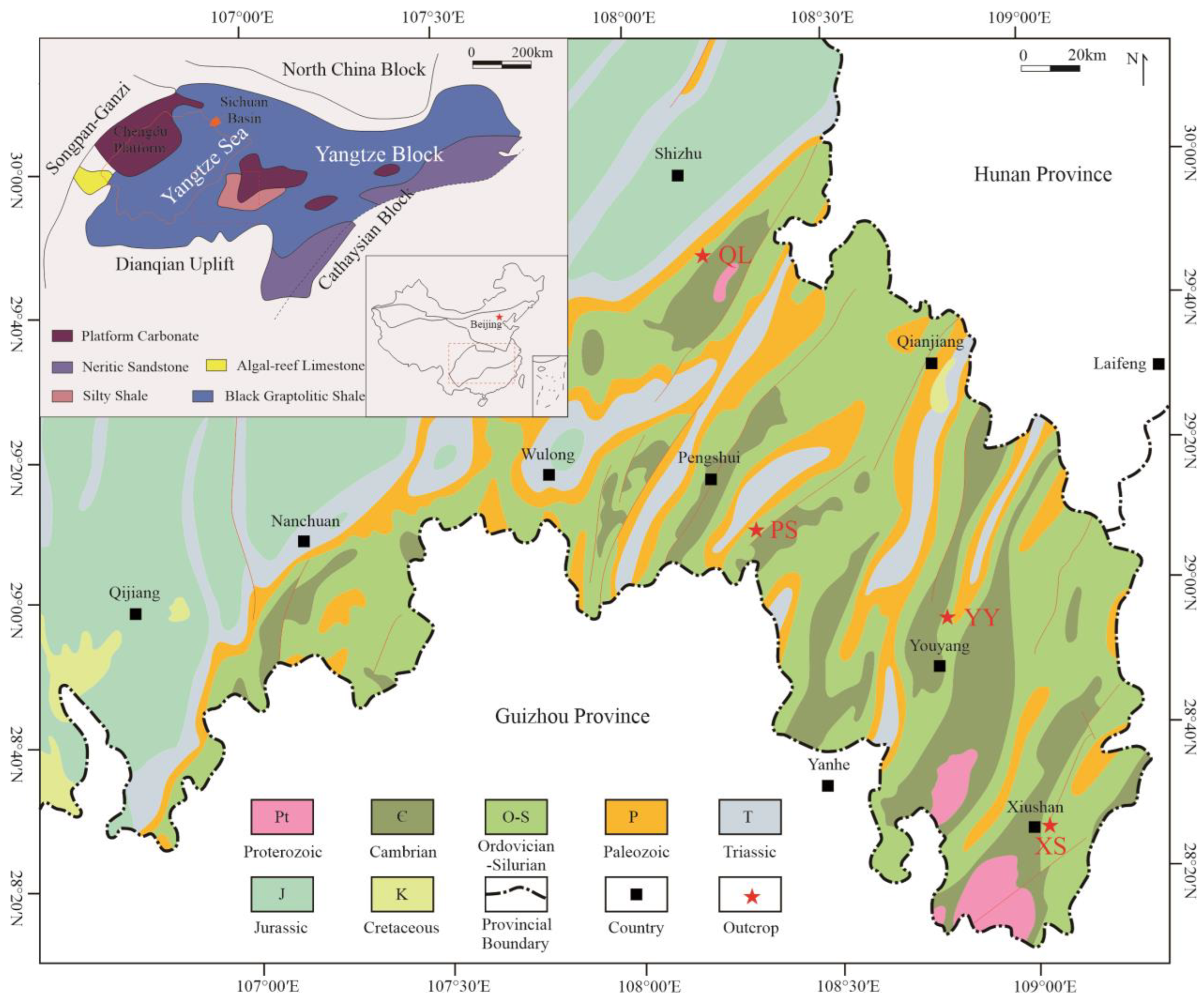
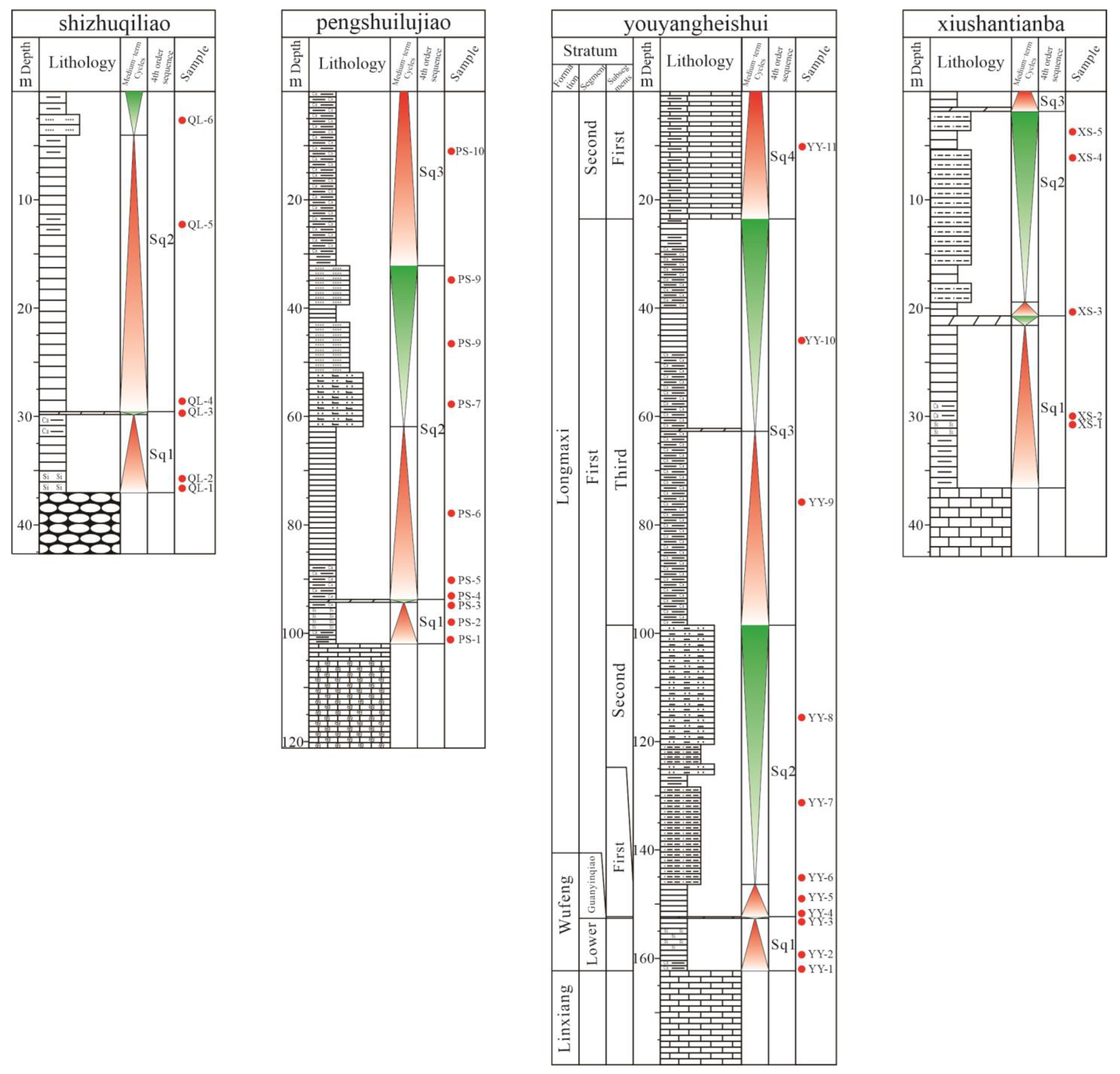
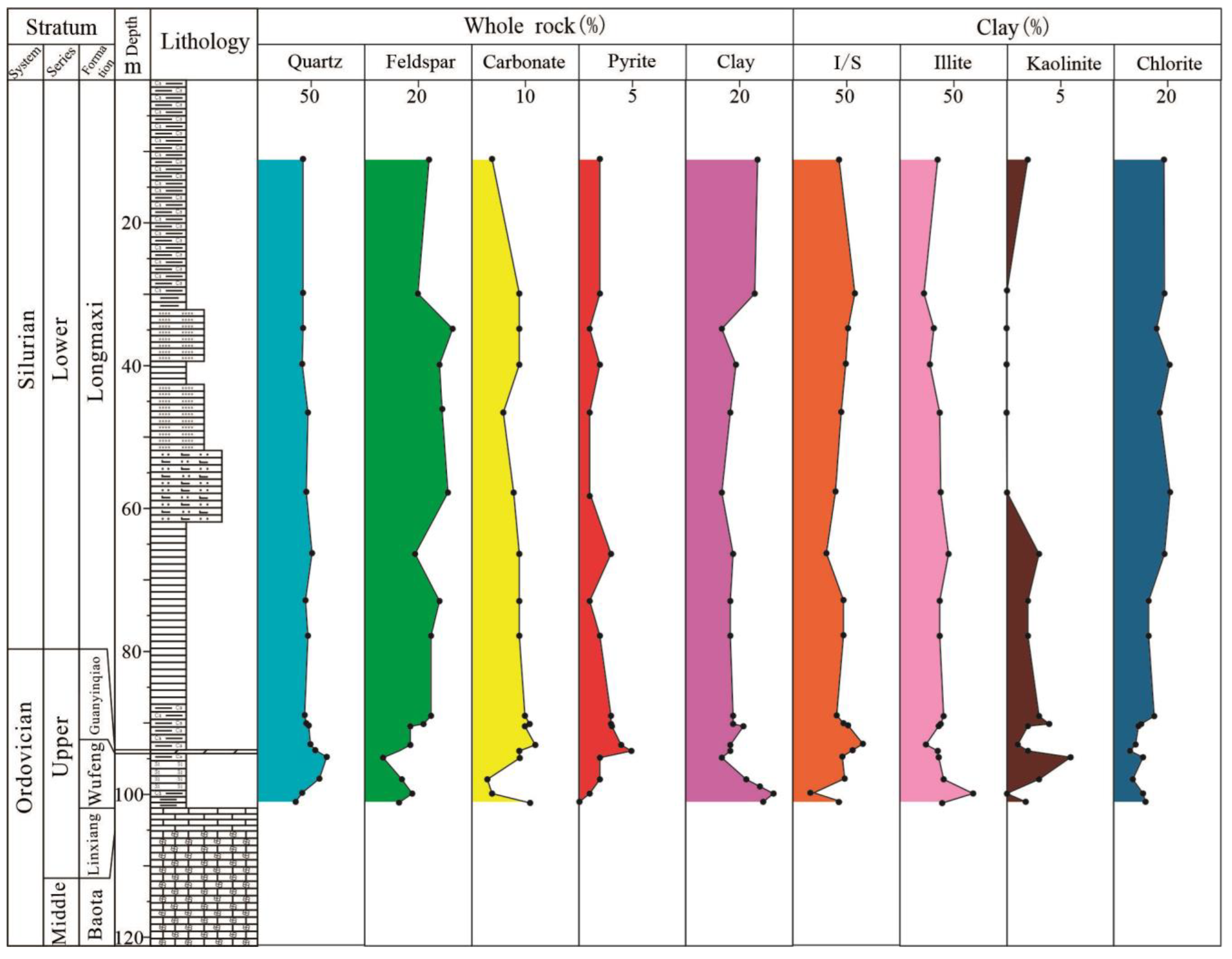
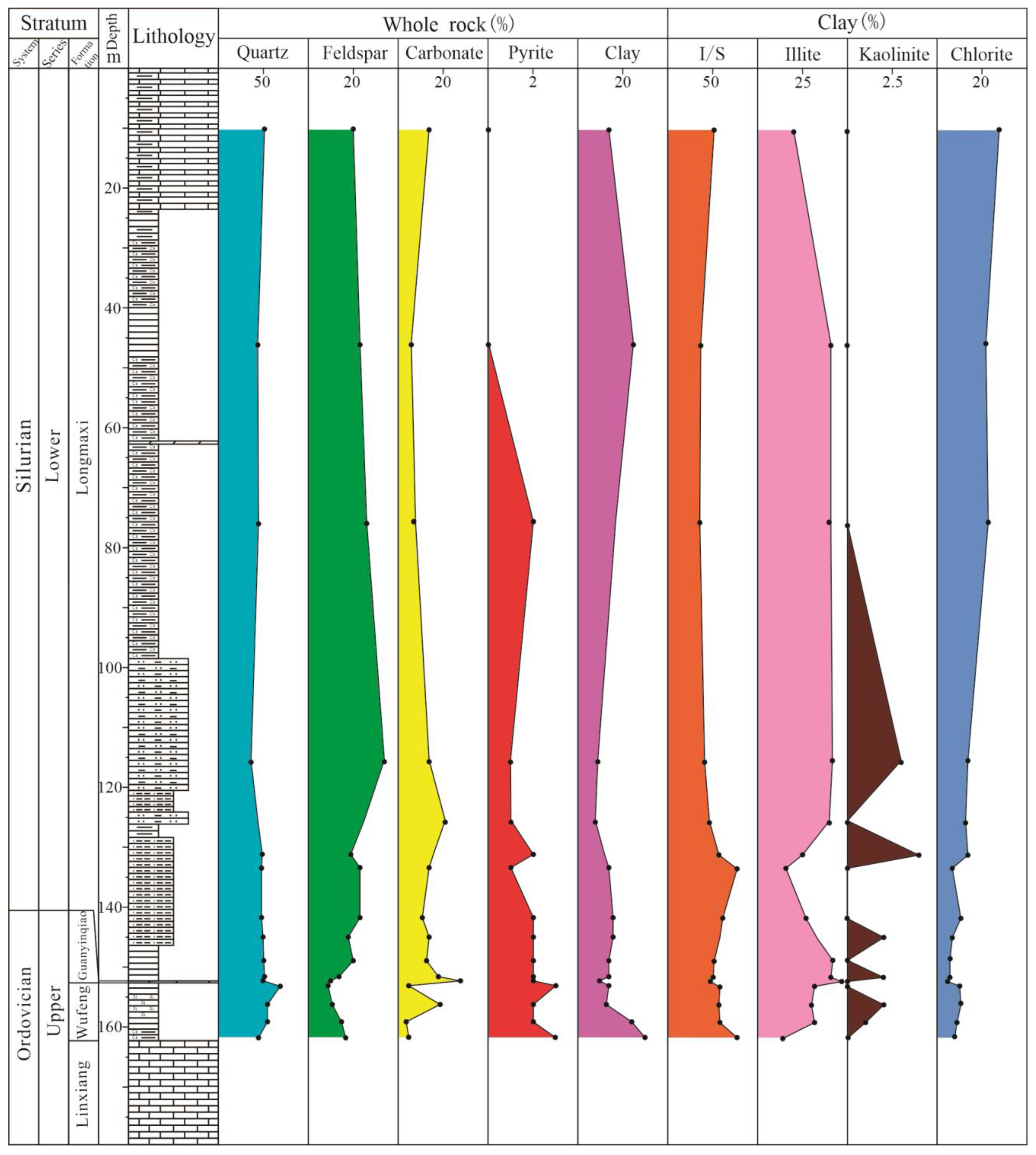
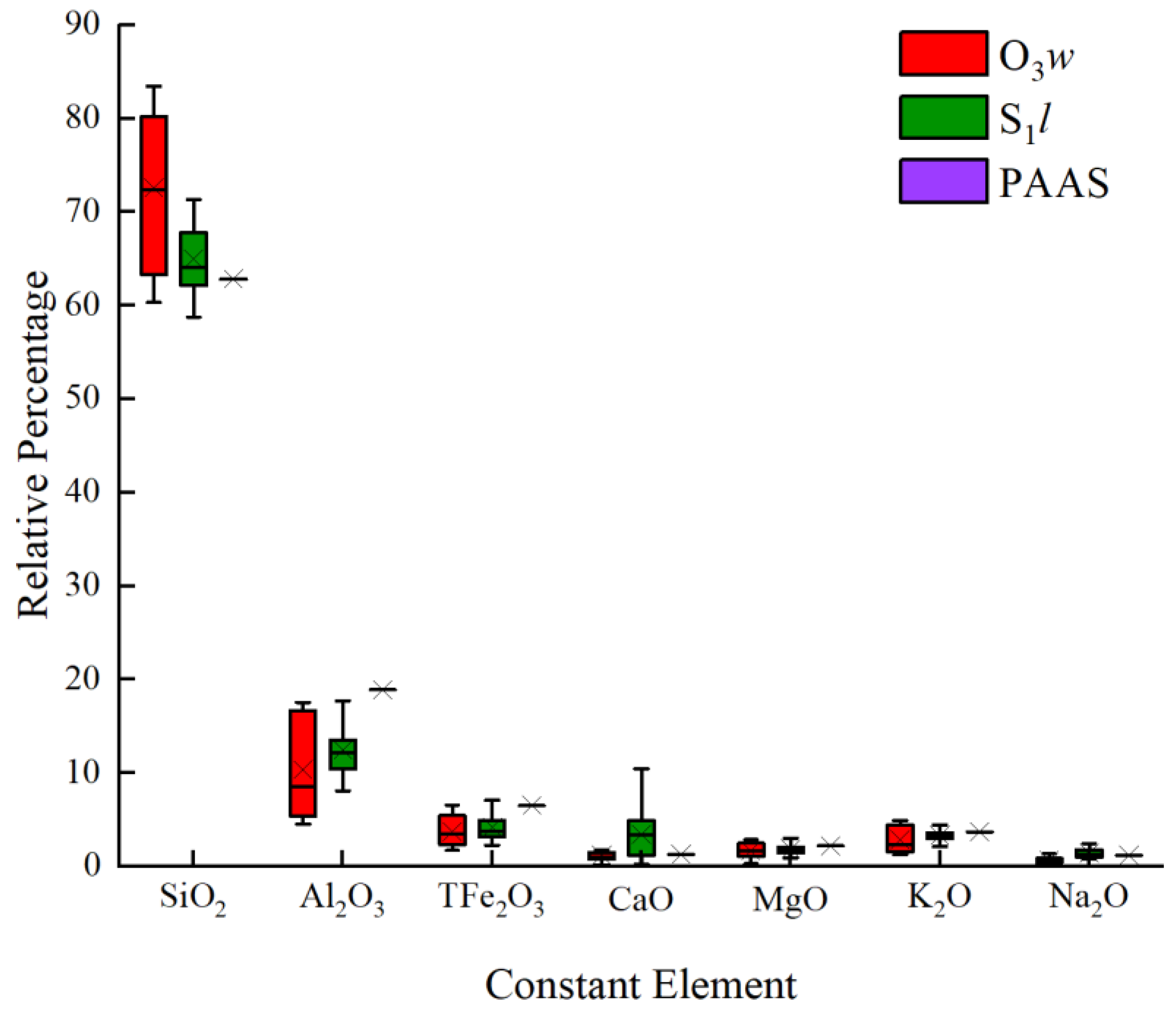
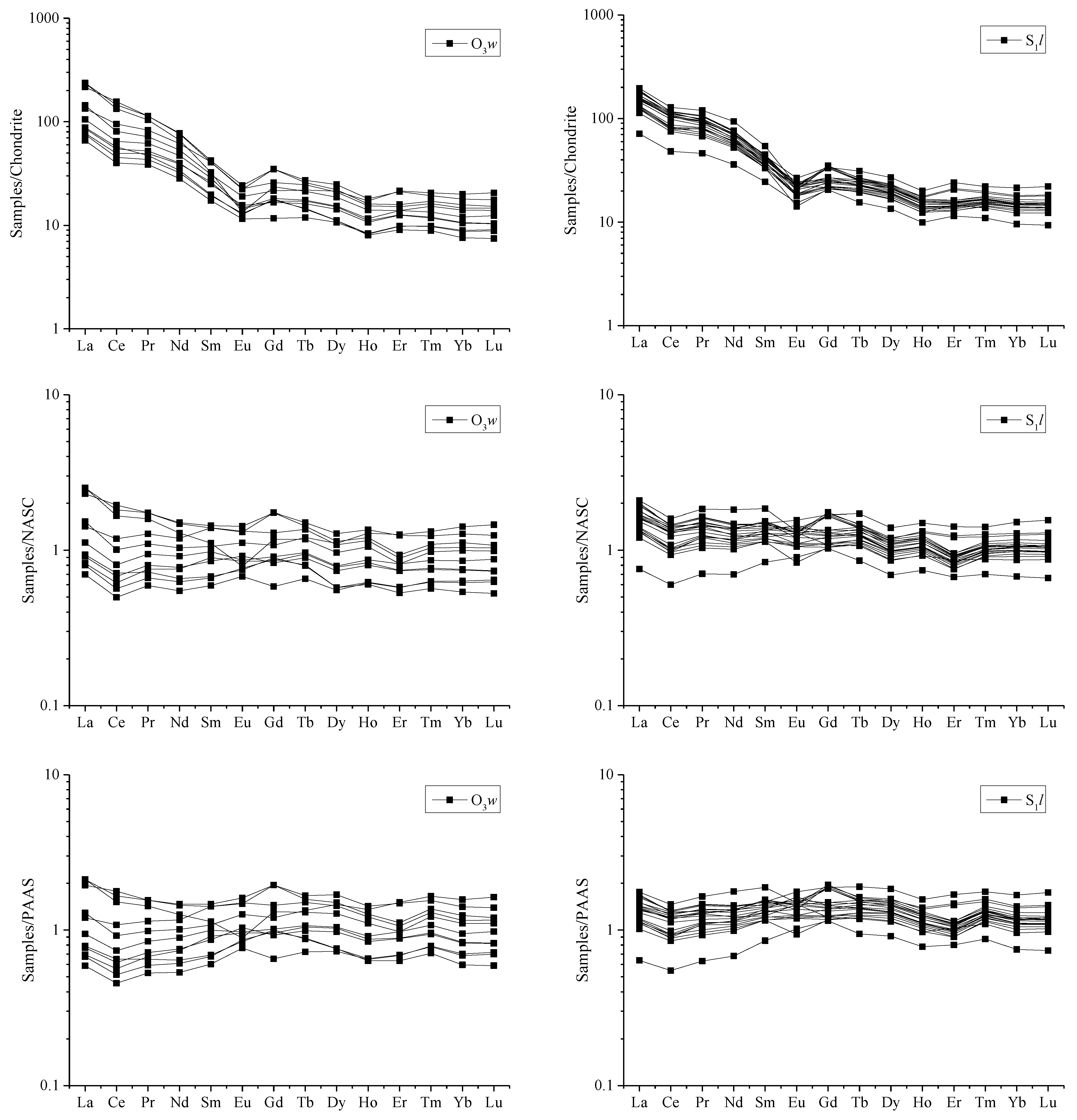
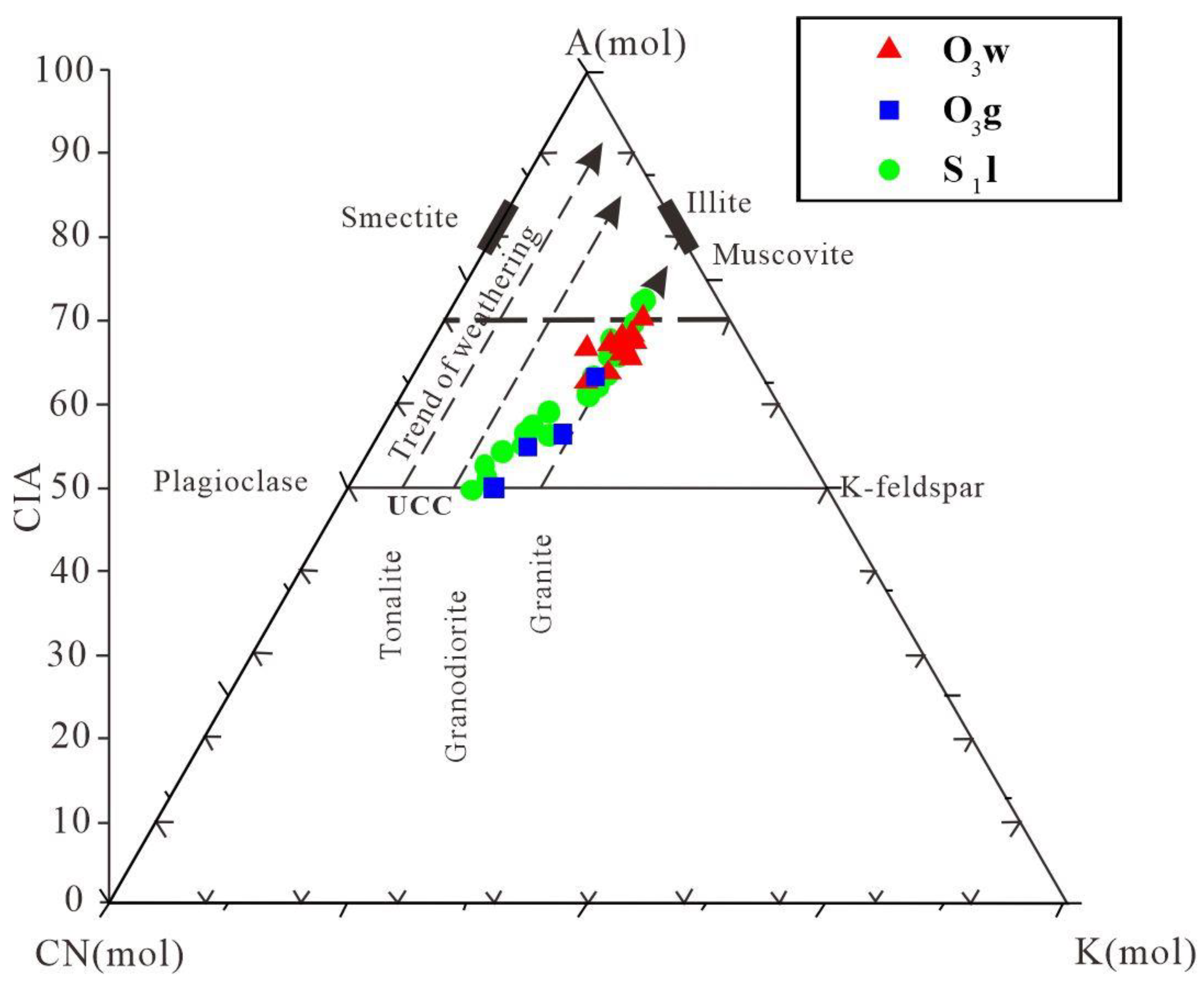
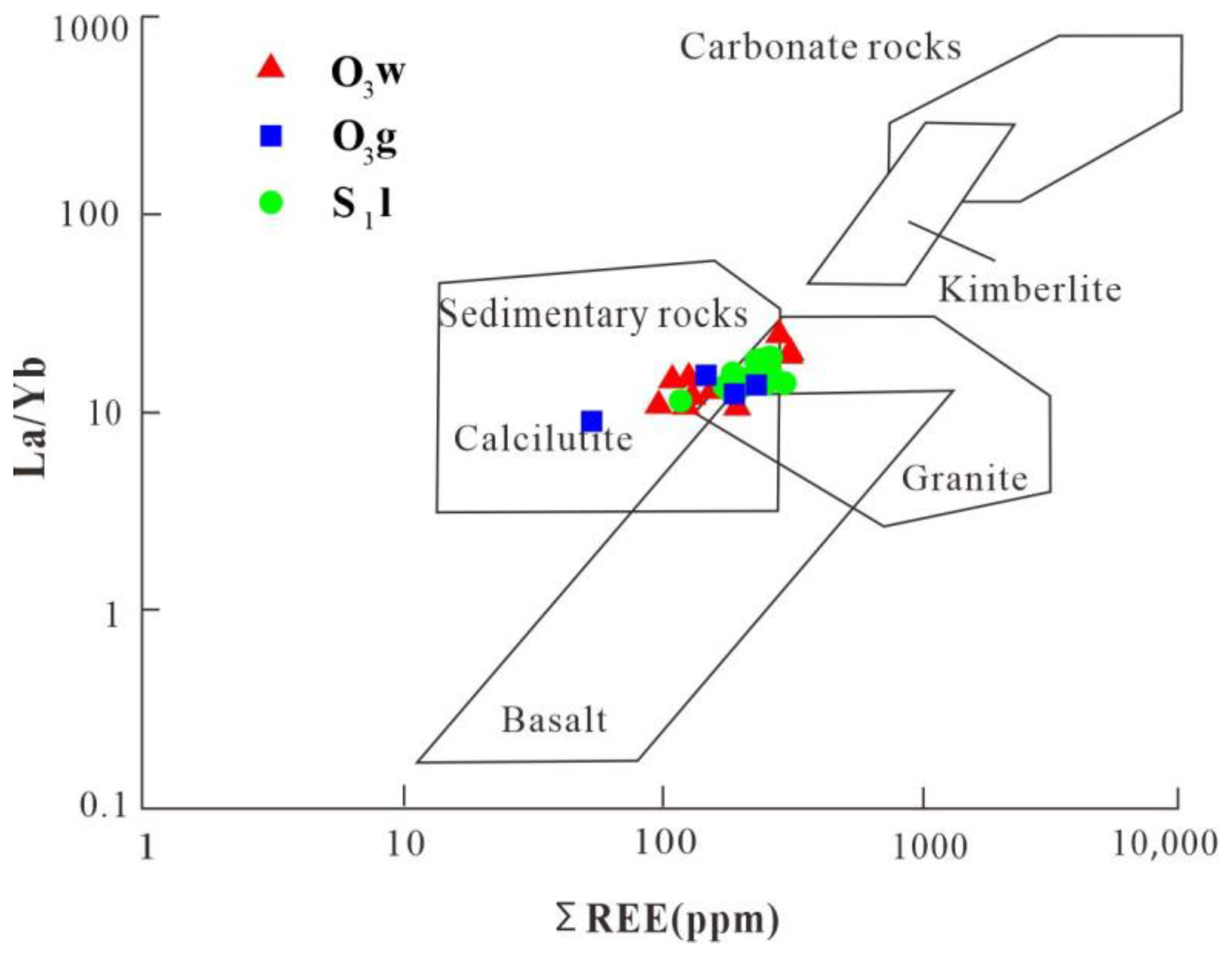


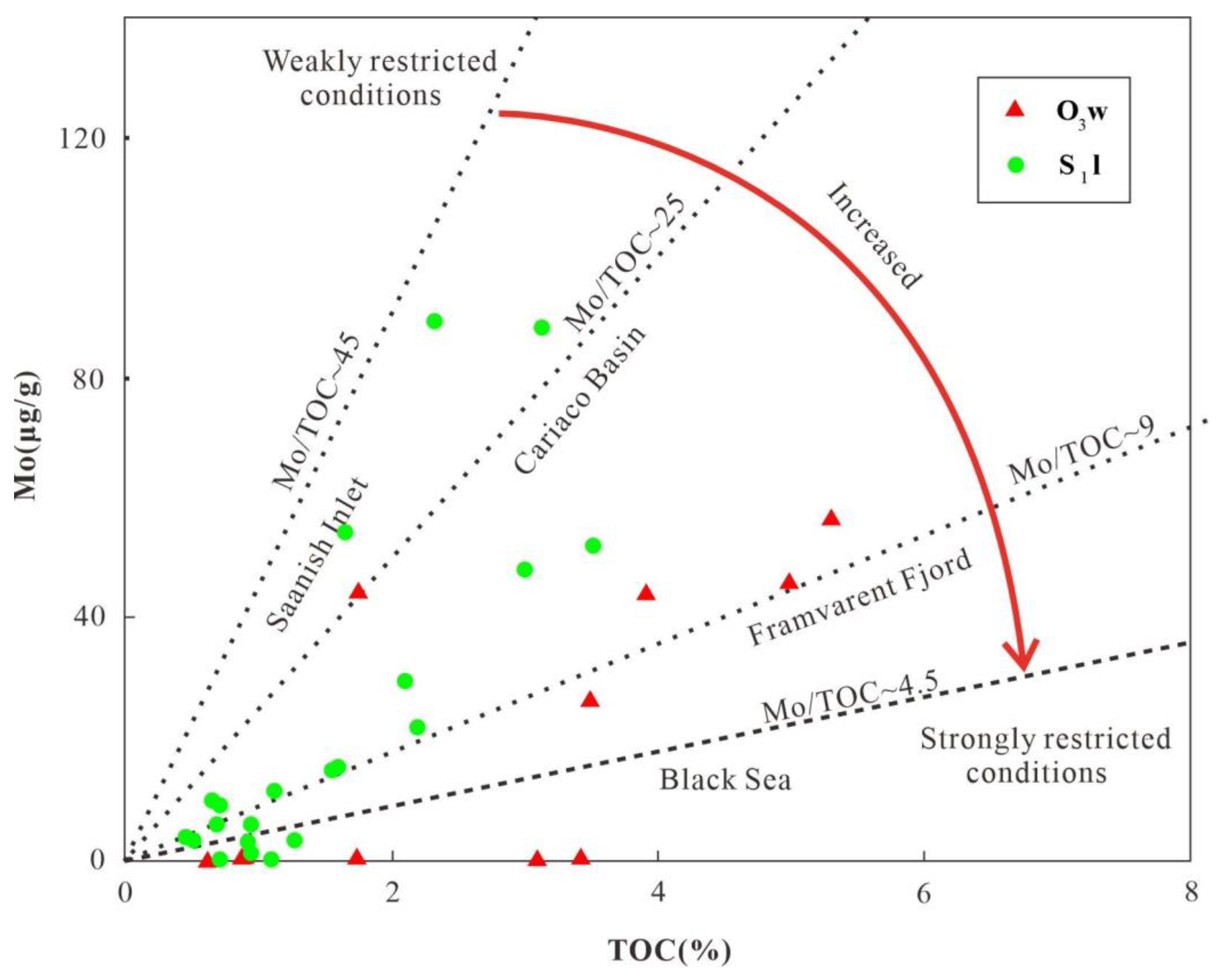
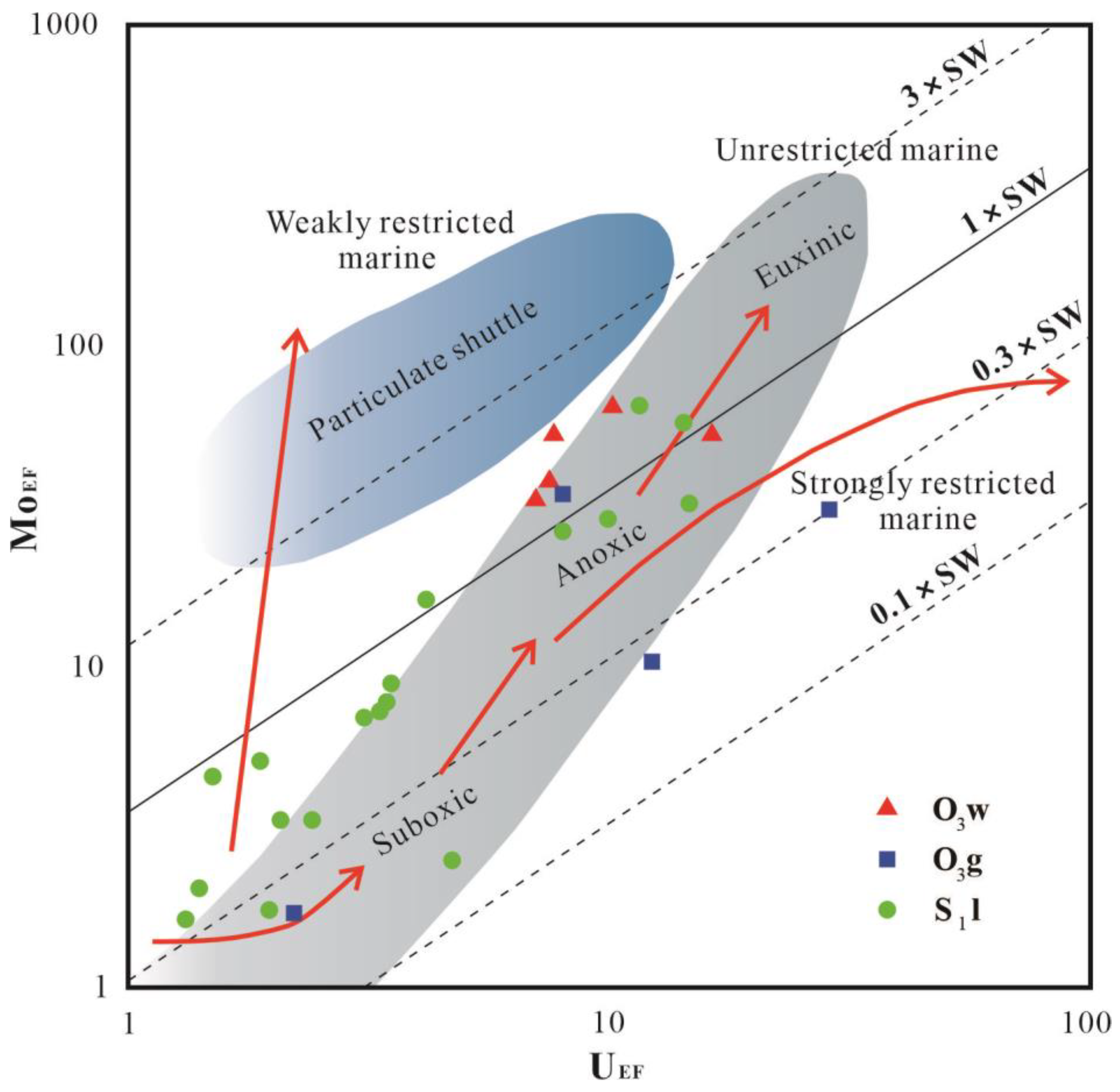
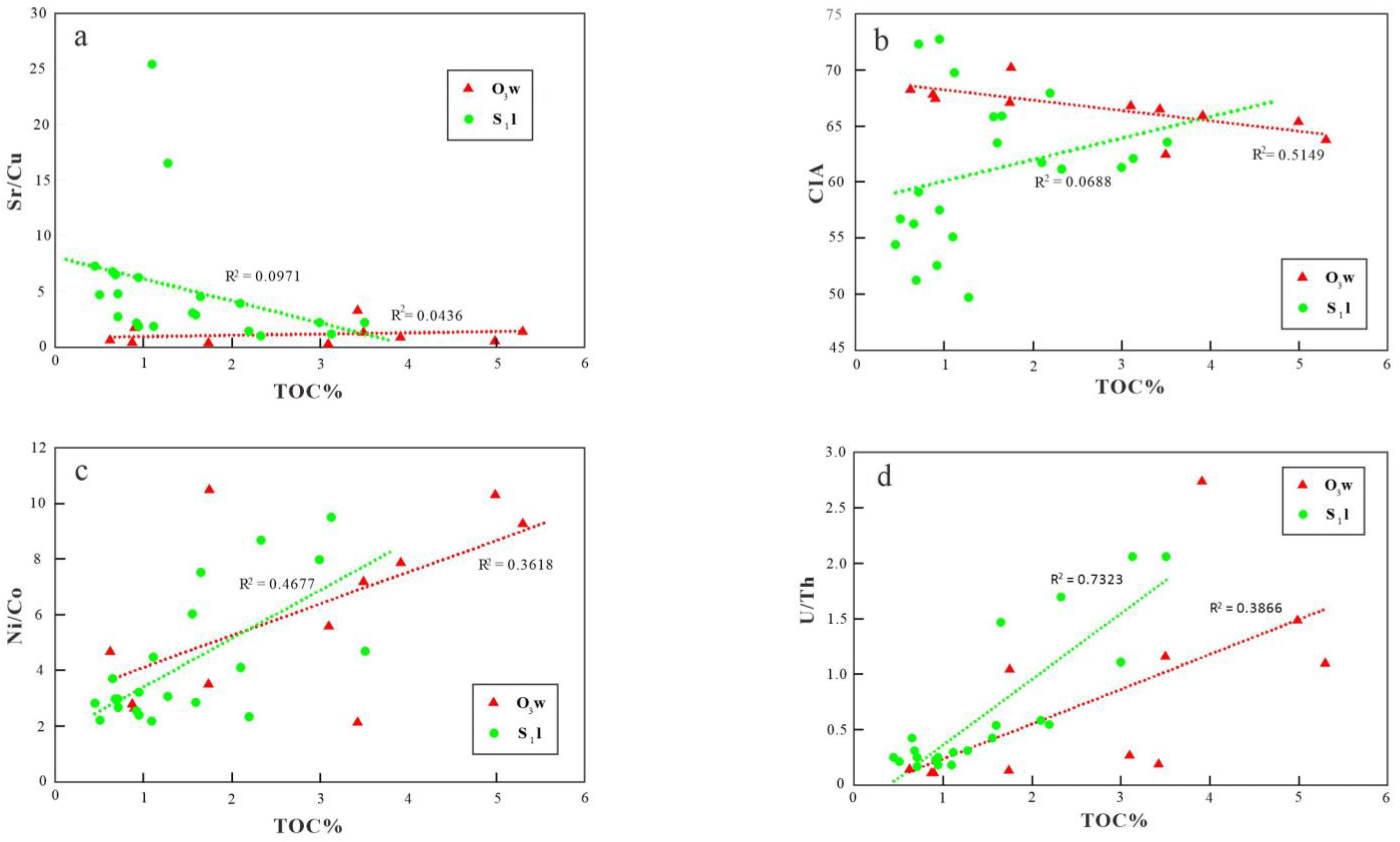

| Position | Sample Number | Mineral Contents (w,%) | ||||||||
|---|---|---|---|---|---|---|---|---|---|---|
| Quartz | K-Feldspar | Plagioclase | Calcite | Dolomite | Siderite | Pyrite | Gypsum | TCCM | ||
| O3w | YY-1 | 45 | 9 | 8 | 3 | 2 | 0 | 3 | 0 | 30 |
| YY-2 | 55 | 8 | 7 | 0 | 4 | 0 | 2 | 0 | 24 | |
| YY-3 | 69 | 4 | 5 | 0 | 5 | 0 | 3 | 0 | 14 | |
| O3g | YY-4 | 50 | 4 | 6 | 23 | 5 | 0 | 2 | 0 | 10 |
| S1l | YY-5 | 52 | 6 | 8 | 13 | 5 | 0 | 2 | 0 | 14 |
| YY-6 | 51 | 8 | 12 | 8 | 5 | 0 | 2 | 0 | 14 | |
| YY-7 | 50 | 7 | 11 | 8 | 6 | 0 | 2 | 0 | 16 | |
| YY-8 | 49 | 8 | 11 | 11 | 5 | 0 | 2 | 2 | 12 | |
| YY-9 | 37 | 9 | 25 | 9 | 5 | 0 | 1 | 5 | 9 | |
| YY-10 | 45 | 6 | 20 | 5 | 3 | 0 | 2 | 2 | 17 | |
| YY-11 | 44 | 8 | 15 | 4 | 2 | 0 | 0 | 2 | 25 | |
| YY-12 | 52 | 7 | 13 | 10 | 4 | 0 | 0 | 0 | 14 | |
| O3w | PS-1 | 36 | 6 | 7 | 8 | 3 | 11 | 0 | 0 | 29 |
| PS-2 | 58 | 6 | 8 | 0 | 3 | 0 | 2 | 0 | 23 | |
| PS-3 | 65 | 3 | 4 | 4 | 5 | 0 | 2 | 3 | 14 | |
| O3g | PS-4 | 54 | 6 | 7 | 6 | 3 | 0 | 5 | 2 | 17 |
| S1l | PS-5 | 50 | 8 | 9 | 6 | 6 | 0 | 4 | 0 | 17 |
| PS-6 | 46 | 8 | 14 | 6 | 5 | 0 | 3 | 0 | 18 | |
| PS-7 | 47 | 8 | 17 | 5 | 4 | 0 | 2 | 0 | 17 | |
| PS-8 | 46 | 10 | 21 | 5 | 3 | 0 | 1 | 0 | 14 | |
| PS-9 | 47 | 8 | 21 | 4 | 2 | 0 | 1 | 0 | 17 | |
| PS-10 | 43 | 10 | 23 | 6 | 3 | 0 | 1 | 0 | 14 | |
| PS-11 | 43 | 7 | 17 | 4 | 0 | 0 | 2 | 0 | 27 | |
| O3w | XS-2 | 55 | 6 | 14 | 0 | 4 | 0 | 0 | 0 | 21 |
| O3g | XS-3 | 46 | 0 | 10 | 20 | 11 | 0 | 1 | 0 | 12 |
| S1l | XS-4 | 46 | 6 | 15 | 12 | 5 | 0 | 2 | 0 | 14 |
| XS-5 | 44 | 11 | 21 | 9 | 4 | 0 | 1 | 0 | 10 | |
| XS-6 | 46 | 10 | 22 | 10 | 3 | 0 | 0 | 0 | 9 | |
| O3w | QL-2 | 57 | 5 | 14 | 8 | 3 | 0 | 0 | 0 | 13 |
| QL-3 | 71 | 2 | 8 | 5 | 2 | 0 | 1 | 0 | 11 | |
| O3g | QL-4 | 39 | 0 | 5 | 0 | 48 | 0 | 1 | 0 | 7 |
| S1l | QL-5 | 49 | 3 | 7 | 0 | 30 | 0 | 3 | 0 | 8 |
| QL-6 | 51 | 4 | 18 | 0 | 6 | 0 | 0 | 0 | 21 | |
| QL-7 | 52 | 0 | 18 | 0 | 3 | 0 | 0 | 0 | 27 | |
Disclaimer/Publisher’s Note: The statements, opinions and data contained in all publications are solely those of the individual author(s) and contributor(s) and not of MDPI and/or the editor(s). MDPI and/or the editor(s) disclaim responsibility for any injury to people or property resulting from any ideas, methods, instructions or products referred to in the content. |
© 2025 by the authors. Licensee MDPI, Basel, Switzerland. This article is an open access article distributed under the terms and conditions of the Creative Commons Attribution (CC BY) license (https://creativecommons.org/licenses/by/4.0/).
Share and Cite
Fu, C.; Feng, Z.; Xu, C.; Zhao, X.; Du, Y. Geochemical Characteristics of Organic-Enriched Shales in the Upper Ordovician–Lower Silurian in Southeast Chongqing. Minerals 2025, 15, 447. https://doi.org/10.3390/min15050447
Fu C, Feng Z, Xu C, Zhao X, Du Y. Geochemical Characteristics of Organic-Enriched Shales in the Upper Ordovician–Lower Silurian in Southeast Chongqing. Minerals. 2025; 15(5):447. https://doi.org/10.3390/min15050447
Chicago/Turabian StyleFu, Changqing, Zixiang Feng, Chang Xu, Xiaochen Zhao, and Yi Du. 2025. "Geochemical Characteristics of Organic-Enriched Shales in the Upper Ordovician–Lower Silurian in Southeast Chongqing" Minerals 15, no. 5: 447. https://doi.org/10.3390/min15050447
APA StyleFu, C., Feng, Z., Xu, C., Zhao, X., & Du, Y. (2025). Geochemical Characteristics of Organic-Enriched Shales in the Upper Ordovician–Lower Silurian in Southeast Chongqing. Minerals, 15(5), 447. https://doi.org/10.3390/min15050447






